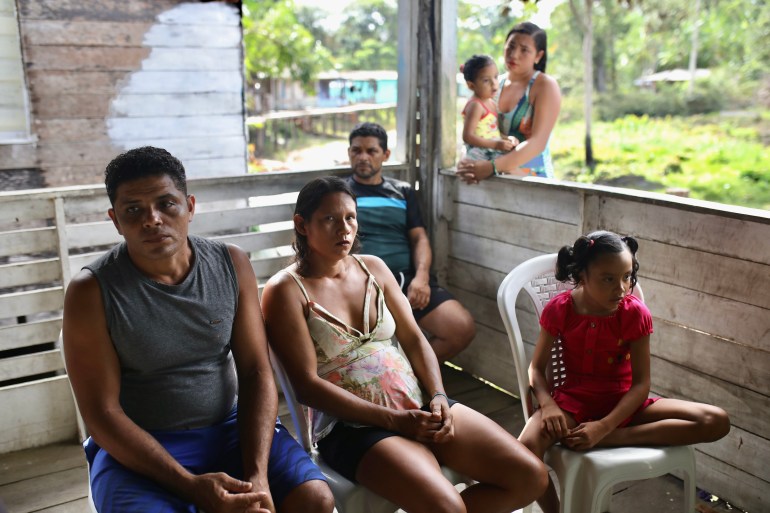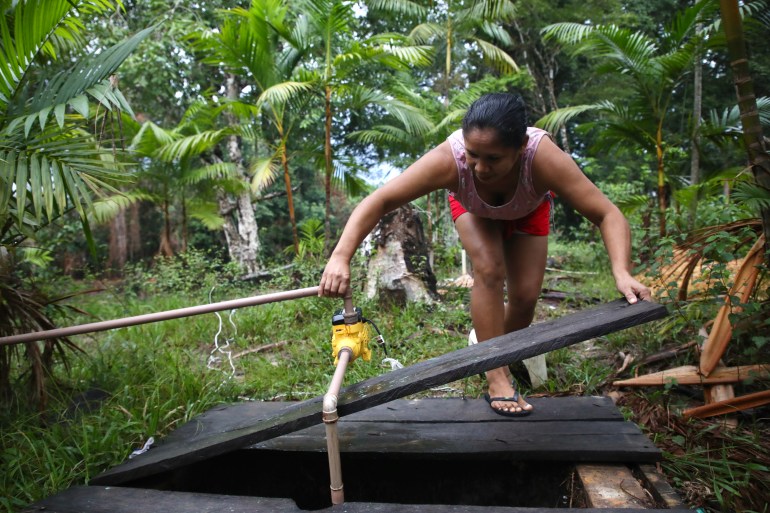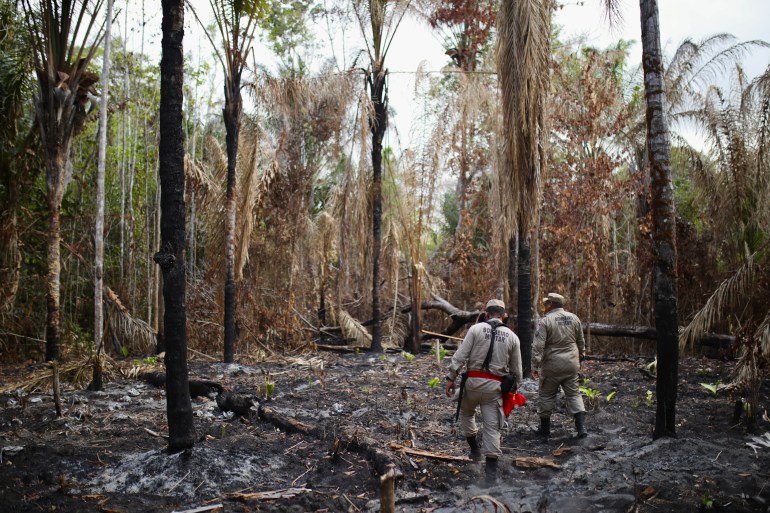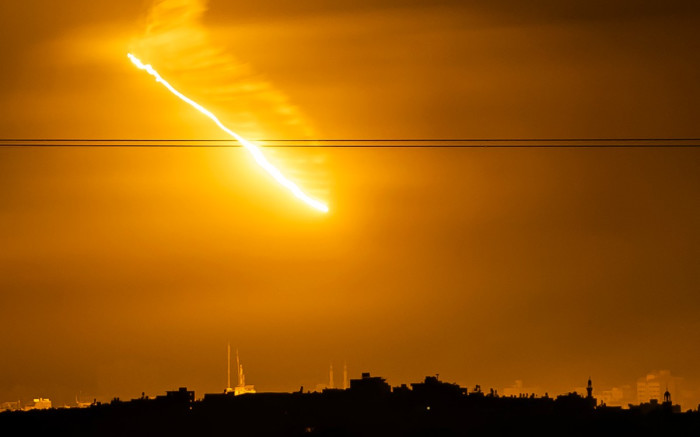
Curralinho, Brazil – For communities on the Brazilian island of Marajó, the ebb and flow of the Canaticu River marks the changing of the seasons.
In the rainy months, the river is several meters deep and babbles beneath the wooden houses that rise on stilts along its banks. Residents rely on water for drinking, cooking and washing.
But when summer comes, the river turns into a stream. Still, the flow is usually enough for locals to meet their daily needs.
This year, however, a severe dry season has devoured large parts of the Brazilian Amazon rainforest. In some areas, all that remains of the Canaticu River is a dark brown trickle, almost entirely laden with bacteria dried out.
“Now we can’t use it for anything. “It wasn’t like this before,” said 36-year-old Elizete Lima Nascimento, who has lived in one of the riverfront communities, Serafina, for a decade.
The drought has created a crisis in towns like Serafina – a crisis that could change their way of life for generations to come.
Hundreds of thousands of people rely on the Amazon rivers and streams for food, transportation and income.
But historically low water levels have forced residents to rethink their relationship with the environment. A tributary, the Rio Negro, plunged to levels not seen in 121 years.
“We are completely dependent on nature,” Maria Vanessa Tavares de Souza, a 36-year-old teacher who lives in Serafina, said during a community meeting to discuss problems caused by the drought.
“Now that climate change has thrown everything out of balance, it will be difficult for us to survive here.”
One of the residents’ main food sources is already under threat: fish. Some are stranded as the river recedes – and in the remaining water, the bodies of other fish float to the surface.
Unusually warm temperatures are suspected to be the cause of the mass extinction. Residents fear that the dead fish could contaminate the water as they decompose.
Nine heatwaves have hit Brazil since the start of the year, with the heat index in Rio de Janeiro rising to nearly 60 degrees Celsius (140 degrees Fahrenheit) in November. The year 2023 is expected worldwide hottest year on record.

Scientists blame rising temperatures and extreme weather on climate change caused by the burning of fossil fuels.
These years The young – A Climate phenomenon Warming of surface waters in the equatorial Pacific region was particularly intense and contributed to drought in the Amazon region.
But the trend towards drier weather is a long time coming. A series of harsh summers had already led many Serafina residents to dig wells in their backyards to access underground water rather than rely on the river.
Others called for the installation of a drinking water distribution system, a major infrastructure project that would consist of pipes and storage facilities. They argue that the wells are unreliable and cannot provide a long-term solution.
Still, well owners like Nascimento say their homemade water systems have been crucial to withstanding the drought.
“The well is extremely important. We use its water for everything – drinking, cooking, making açai, washing ourselves and our clothes,” she said as she lifted the wooden boards in her garden to reveal the six-meter-deep hole.
However, not every family has a well, so residents who do have one share their water supplies with neighbors. Paula Lima, 43, brings home more than 50 liters (13 gallons) every day from a well at her cousin’s house across the community just to meet her family’s needs.
The travel contributed to Lima’s back problems. But she has no choice. Consuming the river water when the water level is so low triggers vomiting and diarrhea – if not worse.

Eleniuda Costa Paiva de Souza, a 30-year-old nurse, recently had to take her two-year-old daughter to the nearest hospital – a journey that required a hike through the jungle and then a five-hour boat ride. Her child had become ill after ingesting the mud from the river.
De Souza said she plans to leave the community soon. “Life here is only getting worse. It will be easier in the city,” she explained.
Isolation is a fact of life for river communities: Serafina is nestled on a serpentine bend in the river, surrounded by rainforest as far as the eye can see. But the weak current of the Canaticu River has made Serafina even more isolated.
To replenish their supplies, locals usually use the river to travel to surrounding towns. However, because the water is so shallow, residents are forced to maneuver their small wooden boats at a snail’s pace to avoid tree trunks and exposed roots.
Many fear that it would take too long to reach the nearest city in the event of a medical emergency.
Downriver, at the mouth of the Canaticu, the community of Curralinho faced its own problems amid the severe drought.
The town of nearly 34,000 people, located on the southern coast of Marajó, saw fires destroy thousands of hectares of nearby rainforest in November.
Curralinho wasn’t the only one to contend with the raging flames. In the first two weeks of October, more than 2,900 fires broke out in Amazonas state, a record number.
The smoke was so thick that it choked the region’s largest city, Manaus, making navigation and the delivery of essential supplies difficult.
Criminal companies have also taken advantage of the drought to burn down the rainforest as part of land grab schemes.

But in Curralinho, small farmers were primarily responsible for the fires. They use fire as a means of crop management to remove the remains of the previous year’s harvest and neutralize the acidity of the soil.
However, tinder dryness caused some of the fires to get out of control.
The city had already declared a state of emergency in September and warned of an increased fire risk during the drought.
Rainfall in the Amazon had been below average for at least six months previously. One of the long-term causes is deforestation: rainforests absorb and release moisture, creating rain cycles. But without the dense trees, the humidity drops and there is less rain.
“Ten to 15 years ago these fires weren’t a problem. “The forest used to be wetter, which meant the flames didn’t spread,” said Ezaquiel Pereira, who works for Curralinho’s environmental department.
Machines that prepare the ground for planting could deter farmers from starting fires. But this equipment can cost about $25,000, Pereira added.
For farmers like 65-year-old Maria Terezina Ferreira Sampaio, such an effort is out of the question.

Sampaio lives with her husband on the outskirts of Curralinho in a small, bare wooden house where she has raised five children. The couple relies on selling crops to supplement their retirement stipend so they can buy food, medicine and clothing.
This year, drought destroyed their orange, coconut, lemon and banana trees and prevented their cassava plants from reaching an edible size.
“I cried and cried. After so many sacrifices…” Sampaio’s words trailed off as she looked despondently at the parched ground, dry leaves crackling beneath her feet.
Despite all efforts, hundreds of people’s crops were destroyed due to the lack of rain, Curralinho’s Environment Minister Esmael Lopes said.
Regionally, the worst of the drought could still be ahead, as El Niño tends to strengthen in December before subsiding in April or May.
In Curralinho, heavy rain showers this month have lifted spirits and given hope of relief from the drought. But even if wet weather came now, it would be too late, said Sampaio.
“We should start harvesting already. Instead, everything is dead,” she said.






Recent Comments